Kontaktinformation
bengt.guss@slu.se, 018-67 32 05
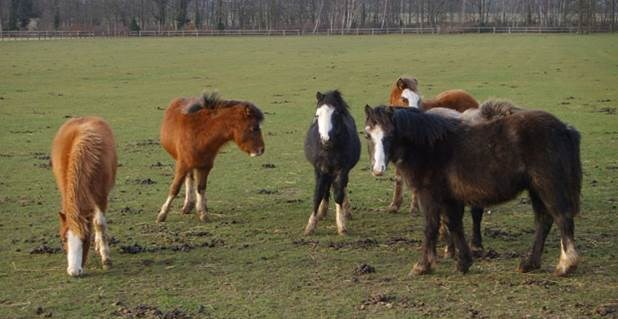
The bacteria we study are Gram-positive belonging to the genera Staphylococcus and Streptococcus. Among these bacteria there are important pathogens causing variety of diseases in both animals humans. The aim of the research has been to study potential virulence factors of these bacteria and their interaction with the host. The factors we have focused on are bacterial cell surface and soluble proteins specifically interacting with host components like extracellular matrix (ECM) or plasma proteins. These types of interactions are considered as crucial steps for the bacteria in the infection process.
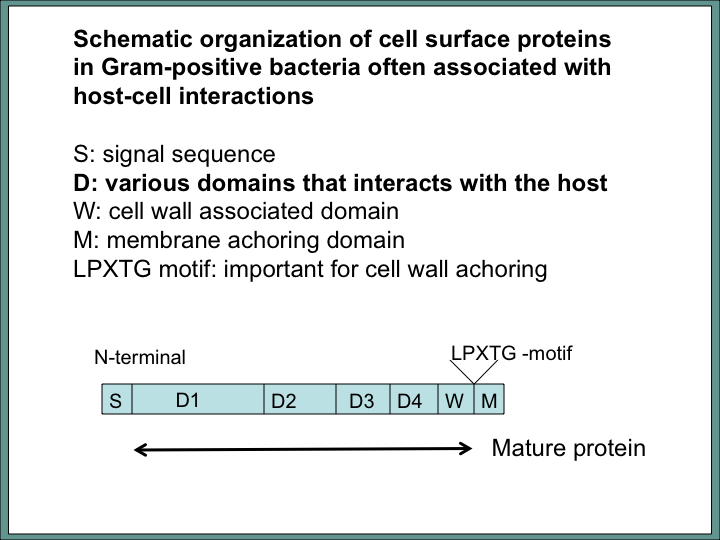
The ability of these bacteria to cause disease in the host is generally assumed to be complex due to several virulence factors like expression of bacterial cell surface receptors (adhesins), capsular polysaccharides, toxins and enzymes that can degrade host components combined with the state of the host. Adhesion of bacteria to components of the ECM at specific sites or structures of the host cells and tissues is considered to be important in the infection process. This interaction is dependent upon specific binding between the adhesins of the pathogen and ligands of the host. The bacteria can also produce proteins, which specifically interact with host components involved in the immune defense and the blood-clotting cascade, thereby e.g. avoiding phagocytosis and affect the infected tissue. The relative importance of a particular interaction may vary depending on different factors like the site of infection or the type or stage of the disease. Many of the extracellular proteins of these bacteria are multifunctional in their binding properties which can be explained by their characteristic structure. Usually they consist of various domains which might be repetitive. Therefore the role of an individual protein cannot be judged by considering a selected single binding property. Therefore it is of importance to study these proteins at the molecular level and also to extend the studies into cell and animal experiments.
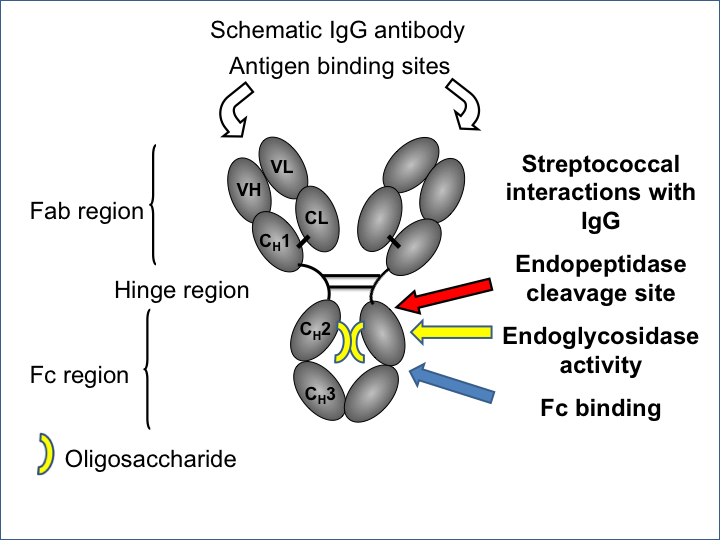
Example of various streptococcal interactions with IgG affecting the immune defense. The endopeptidase activities of the S. equi enzymes. IdeE and IdeE2, the endoglycosides activity of the enzyme EndoSe and cellsurface bound protein EAG which binds to the Fc-portion of IgG.
Our group has for many years, by molecular biological methods, studied adhesins or secreted proteins from pathogenic staphylococci and streptococci, which interact with different ECM and plasma proteins. The aim is to study the molecular mechanisms of the respective bacterial/host interactions and by collaborations with other research groups extend these studies into cell and animal experiments.
Although our scientific activity can be described as basic science there is also an applied part since it is a strong demand from the society to develop novel methods to combat pathogenic bacteria.
During the years we have been involved in several projects aiming to develop vaccines against pathogenic staphylococci and streptococci. The aims of these projects were briefly to develop vaccines to protect animals and humans against various diseases caused by pathogenic staphylococci and streptococci.
Studies of virulence factors of Streptococcus equi and Streptococcus zooepidemicus
For many years we have studied Streptococcus equi subspecies equi (S. equi) and subspecies zooepidemicus (S. zooepidemicus). Both subspecies are associated with diseases in horses where S. zooepidemicus is the most frequently isolated opportunistic pathogen causing respiratory-, wound-, uterine- infections, and reproduction disorders. Streptococcus zooepidemicus can be isolated from different animals and occasionally from humans while the S. equi is restricted to horses causing a serious and highly contagious respiratory disease called strangles.
In our studies we have described different extracellular potential virulence factors of these subspecies and studied the interactions of these factors with the host. By collaboration with other research groups we have also extended our studies to cell and animal experiments.
Vaccine against strangles
Since there was no safe and efficient vaccine on the market against strangles we many years back started a collaboration project with the aim to develop a novel safe and efficient vaccine against strangle based on recombinant S. equi proteins. Briefly the results have so far been very promising and the project has developed in to a novel company called Intervacc AB which is the process of bringing the vaccine into the market.
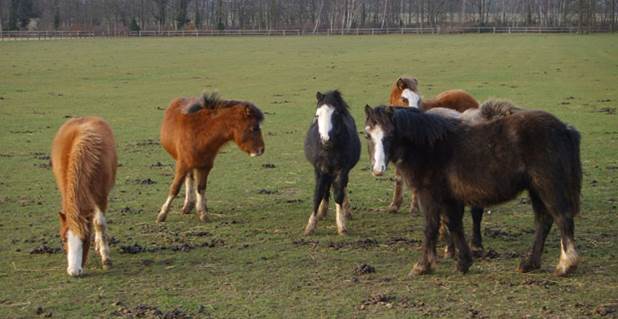
Welsh mountain ponies at AHT used in vaccination studies. Photo: Lars Frykberg
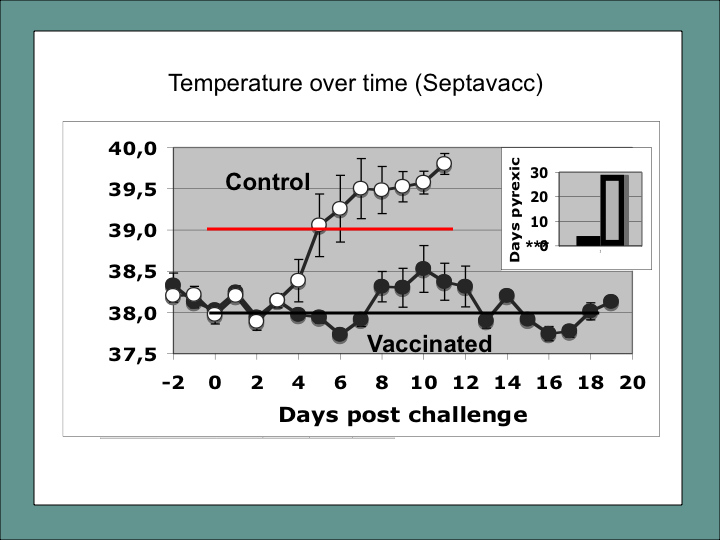
Example of vaccination and challenge experiments in horses using a combination of various recombinant S. equi proteins (Septavacc).
Modified from Guss et al 2009 PLoS Pathog
Collaborations with other research groups
Concerning the projects on streptococci we have collaborations with other research groups lead by:
Prof. Jan-Ingmar Flock, Karolinska Institute
Prof. Kristofer Rubin, Lund University
Prof. Gunnar Pejler, Swedish University of Agricultural Sciences
Dr. Andrew Waller, Animal Health Trust, New Market, UK
Selected recent references
1: Reyhani V, Seddigh P, Guss B, Gustafsson R, Rask L, Rubin K. Fibrin binds tocollagen and provides a bridge for αVβ3 integrin-dependent contraction ofcollagen gels. Biochem J. 2014 May 20. Epub ahead of print]
2: Rönnberg E, Johnzon CF, Calounova G, Faroldi GG, Grujic M, Hartmann K, RoersA, Guss B, Lundequist A, Pejler G. Mast cells are activated by Staphylococcusaureus in vitro but do not influence the outcome of intraperitonealStaphylococcus aureus infection in vivo. Immunology. 2014 Apr 1. doi:10.1111/imm.12297. [Epub ahead of print]
3: Rönnberg E, Calounova G, Guss B, Lundequist A, Pejler G. Granzyme D is a novelmurine mast cell protease that is highly induced by multiple pathways of mastcell activation. Infect Immun. 2013 Jun;81(6):2085-94.
4: García-Faroldi G, Rönnberg E, Orro A, Calounova G, Guss B, Lundequist A,Pejler G. ADAMTS: novel proteases expressed by activated mast cells. Biol Chem.2013 Feb;394(2):291-305.
5: Flock M, Frykberg L, Sköld M, Guss B, Flock JI. Antiphagocytic function of an IgG glycosyl hydrolase from Streptococcus
equi subsp. equi and its use as avaccine component. Infect Immun. 2012 Aug;80(8):2914-9.
6: Rosander A, Guss B, Frykberg L, Björkman C, Näslund K, Pringle M Identification of immunogenic proteins in Treponema phagedenis-like strain V1 from digital dermatitis lesions by phage display. Vet Microbiol. 2011 Dec15;153(3-4):315-22.
7: van Wieringen T, Kalamajski S, Lidén A, Bihan D, Guss B, Heinegård D, FarndaleRW, Rubin K. The streptococcal collagen-binding protein CNE specificallyinterferes with alphaVbeta3-mediated cellular interactions with triple helicalcollagen. J Biol Chem. 2010 Nov 12;285(46):35803-13.
8: Guss B, Flock M, Frykberg L, Waller AS, Robinson C, Smith KC, Flock JI. Getting to grips with strangles: an effective multi-component recombinant vaccine for the protection of horses from Streptococcus equi infection. PLoS Pathog. 2009Sep;5(9):e1000584.
9: Hulting G, Flock M, Frykberg L, Lannergård J, Flock JI, Guss B. Two novel IgG endopeptidases of Streptococcus equi. FEMS Microbiol Lett. 2009 Sep;298(1):44-50.
10: Lidén A, van Wieringen T, Lannergård J, Kassner A, Heinegård D, Reed RK, GussB, Rubin K. A secreted collagen- and fibronectin-binding streptococcal proteinmodulates cell-mediated collagen gel contraction and interstitial fluid pressure.J Biol Chem. 2008 Jan 18;283(3):1234-42.
11: Waller A, Flock M, Smith K, Robinson C, Mitchell Z, Karlström A, LannergårdJ, Bergman R, Guss B, Flock JI. Vaccination of horses against strangles usingrecombinant antigens from Streptococcus equi. Vaccine. 2007 May 4;25(18):3629-35.
12: Lannergård J, Guss B. IdeE, an IgG-endopeptidase of Streptococcus equi ssp.equi. FEMS Microbiol Lett. 2006 Sep;262(2):230-5.
13: Flock M, Karlström A, Lannergård J, Guss B, Flock JI. Protective
effect ofvaccination with recombinant proteins from Streptococcus equi subspecies equi in a strangles model in the mouse. Vaccine. 2006 May 8;24(19):4144-51.
14: Karlström A, Jacobsson K, Guss B. SclC is a member of a novel family ofcollagen-like proteins in Streptococcus equi subspecies equi that are recognised by antibodies against SclC. Vet Microbiol. 2006 Apr 16;114(1-2):72-81.
15: Lidén A, Karlström A, Lannergård J, Kalamajski S, Guss B, Rubin K, Rydén C. Afibronectin-binding protein from Streptococcus equi binds collagen and modulates cell-mediated collagen gel contraction. Biochem Biophys Res Commun. 2006 Feb10;340(2):604-10.
16: Lannergård J, Flock M, Johansson S, Flock JI, Guss B. Studies offibronectin-binding proteins of Streptococcus equi. Infect Immun. 2005Nov;73(11):7243-51.
Group members
Bengt Guss, Professor
Lars Frykberg, Associated Professor
Greta Hulting, PhD student
bengt.guss@slu.se, 018-67 32 05